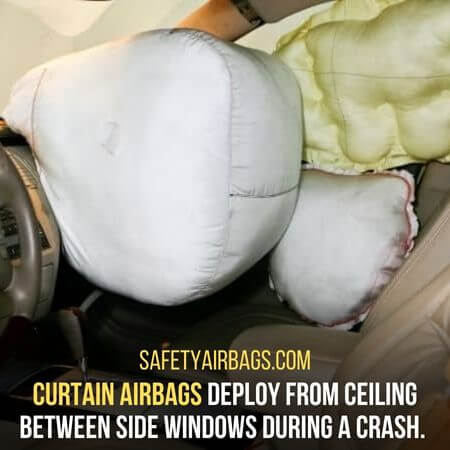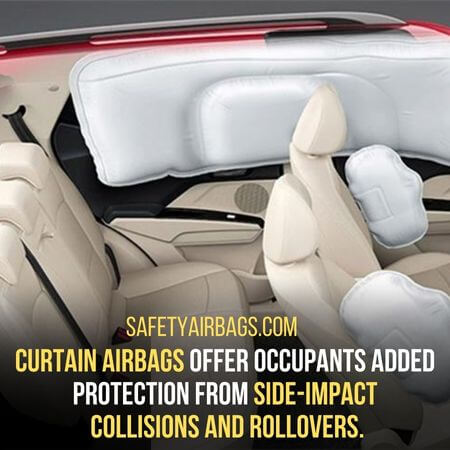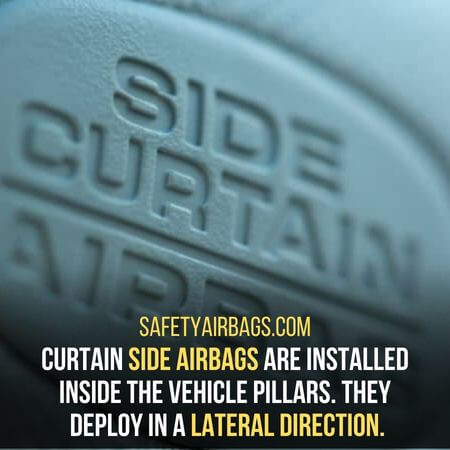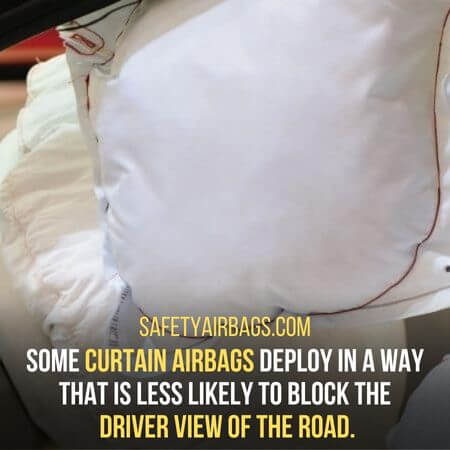Curtain airbags are an important part of a vehicle’s overall safety system. For example, they protect the occupants in a side impact or rollover crash.
What Will I learn
In this article, we will take a deeper look at how curtain airbags work and their types. But first, it is important to note the safety benefits of these airbags and their limitations and concerns.
How Curtain Airbags Work – Mechanism
Curtain airbags deploy from the ceiling between the side windows during a crash. They protect occupants’ heads from hitting the vehicle’s windows or other hard surfaces.
Curtain airbags usually deploy in three stages:
Stage 1 – Release Of Gas Into The Bag:
A sensor is placed at the base of the side windows to exude the airbag. When an impact occurs, this sensor triggers an inflator, releasing gas into the bag.

This gas inflates the airbag, creating an envelope-like structure. So why is it called a Curtain airbag? This is because when the airbag deploys, it looks like a curtain.
Some curtain airbags also have a rope attached to the bottom. It helps keep the bag in place when it deploys.
Stage 1 deployment is usually triggered when the vehicle’s side impacts are moderate.
Or it happens when the vehicle rolls over. Some curtain airbags are also designed to be deployed in multiple stages.
In stage 1, the main section of the curtain will deploy. This helps to protect occupant’s head from being hit by objects inside the vehicle.
Stage 2 – Tether Deployment:
In stage 2, the rope attached at the bottom of the curtain airbag will deploy. This helps keep the airbag in place and provides additional protection for the occupants.
Once this happens, it limits the occupants’ head and neck movement. Thus it provides an extra layer of protection.
Tether is a flexible strap attached to the curtain airbag. It helps to keep the airbag in place when it is deployed. In addition, it provides additional protection for the occupants.
This stage is very important as it helps to keep the airbag in its intended position. In addition, it reduces any movement of the occupant’s neck.
Also, the rope attached at the bottom of the curtain airbag absorbs some of the force from its deployment. Thus, it does not cause any harm to the occupants.
Stage 3 – Airbag Deployment:
In stage 3, the airbag will fully deploy. Curtain airbags protect both front and rear seat occupants from side-impact collisions. It is located along the roof line, beside the windows.
Once deployed, it helps to absorb the impact energy. It reduces injuries to occupants’ heads and necks.
Some curtain airbags are designed to be deployed in two stages. The first stage is a cushioning effect, and the second is an impact absorption layer.
However, all curtain airbags are designed to deflate quickly after deployment.
When fully deployed, its purpose is to reduce the movement of the occupant’s neck.
With this feature, the curtain airbag provides both safety and comfort for the occupants.
How Curtain Airbags Are Compared To Other Airbags
Curtain airbags are not as large and powerful as other frontal airbags. However, they provide additional protection in case of a side impact or rollover accident.
Curtain airbags are designed to deploy quickly before the occupants can move too far forward or back.
This provides valuable time for occupants to prepare for an impact. Otherwise, it could be more damaging than a larger frontal airbag alone.
Curtain airbags are also less likely to cause injury when deployed. Their size and location keep them away from occupants and torsos.
Curtain airbags offer occupants added protection from side-impact collisions and rollovers.
This can mean the difference between life and death for those involved in such accidents.
Curtain airbags are a great way to increase safety levels inside the vehicle. So it is worth considering them when shopping for a new car.
Verdict:
Additionally, curtain airbags provide better protection for rear-seat passengers who frontal airbags cannot reach.
Curtain airbags are designed to deploy slightly later than front-seat airbags.
They give rear-seat occupants more time to prepare for an impact if they sit too far forward or backward in their seats.
Curtain airbags also work better than front-seat airbags in preventing ejection during a rollover accident.
The curtain airbags extend further than standard airbags. As a result, they can protect passengers from being thrown out of the vehicle through side windows.
Finally, there is an extra layer of protection provided by the curtain airbags means. They help absorb more energy and reduce occupant injury in certain crashes.
Types Of Curtain Airbags
Curtain airbags have a range of designs and specifications, depending on the needs and requirements of the car manufacturer.
There are a few types of curtain airbags:
1. Single Curtain Airbags:
This type of airbag is the most commonly used in vehicles. They are deployed from the headliner above the side windows.
They protect occupants in a side-impact collision or rollover accident. In addition, they are unique in how they are designed to envelop the occupant’s chest area.
Single-curtain airbags are generally made of nylon. They have a special material that helps absorb energy during the crash.
As a single airbag, they are usually deployed in pairs, one for each side of the vehicle.
2. Multi-Curtain Airbags:
Multi Curtain airbags are generally more advanced than single-curtain airbags.
They provide additional protection to vehicle occupants. They deploy from the headliner above the side windows and the A-pillar in front of the side windows.
They help shield occupants during rollover accidents. They protect them by providing a larger coverage area than single Curtain airbags.
Multi Curtain airbags are usually nylon, similar to single Curtain airbags.
But they have a different material coating that helps absorb energy during impact and protects occupants more effectively.
3. Side-impact Curtain Airbags:
Side-impact curtain airbags protect the heads of occupants seated on the side of the car facing the impact.

They extend from one side of the vehicle to another. Thus, they cushion and protect against head injuries in a side-on collision.
Some side-impact curtain airbags are designed to deploy in two stages. The first stage deploys in the event of a mild side-impact collision.
The second stage will only be activated if the impact is more severe. Some installations may also have Roller sensors.
This will deploy the side curtain airbag even in vehicle rollover cases.
4. Rollover Curtain Airbag:
Rollover curtain airbags are designed to protect occupants during rollover crashes.
They are usually installed on both sides of the vehicles and deploy in a downward direction.
Rollover curtain airbags help protect occupants during rollover crashes. In addition, rollover curtain airbags provide extra protection for occupants in all seating positions.
The rollover curtain airbag deploys when any of the two sensors is triggered. It covers both sides of the roof where occupants are seated.
Also, these airbags provide an updated shield when the vehicle rolls.
The rollover curtain airbag deployment helps to protect occupants from being ejected from the vehicle and minimizes the risk of injury.
5. Curtain Side Airbags:
Curtain side airbags are installed inside the vehicle pillars. They deploy in a lateral direction.
These airbags help protect passengers by providing extra protection during side-impact crashes.
Curtain side airbags provide extra protection for occupants seated next to the impacted side of the vehicle.
They can also help to reduce injury from flying debris during a crash.
The different types of curtain airbags provide various levels of protection to vehicle occupants.
Curtain airbags are designed to deploy in the event of a crash. But they can also be manually deployed by using a switch.
Safety Benefits of Curtain Airbags
There are several safety benefits associated with curtain airbags. These include:
1. Side Impact Protection:
Curtain airbags provide additional protection to vehicle occupants during a side-impact crash.
When any curtain airbag is deployed, it acts as a barrier between the occupant and the side window or door frame.

The airbag helps to absorb much of the impact energy from the crash, reducing injury risk.
Any side-impact airbag can reduce head injury risk by cushioning between the window or door frame and the occupant.
This makes curtain airbags an important safety feature for vehicles. And especially ones designed to transport children.
2. Improved Occupant Retention:
Curtain airbags also help prevent occupants from being ejected from the vehicle in a rollover crash.
The airbag helps to keep occupants inside the vehicle, protecting them from further injury.
Also, curtain airbags deploy slightly before the vehicle hits the ground.
Thus, they cushion occupants and reduce their impact when they hit the side of the vehicle.
When deployed correctly, curtain airbags can provide better protection for occupants than seatbelts alone.
Although curtain airbags are primarily designed for adults, they can also be a great safety feature for vehicles transporting children.
In particular, curtain airbags can protect children in rear-facing child restraints without increasing their risk of injury.
3. Improved Vision:
Curtain airbags can also improve visibility in a crash. In addition, the airbag helps to reduce the amount of debris, dust, and smoke in the passenger cabin.
This increases visibility for the occupants and allows them to see their exit points more clearly.
Some curtain airbags deploy in a way that is less likely to block the driver view of the road.

Any material blocking the driver can be dangerous and cause an accident.
In a collision, any distraction can take away focus from the road. Curtain airbags reduce this risk, making driving safer.
Also, thanks to the design of curtain airbags, they can help reduce the severity of injuries sustained in a side-impact collision.
4. Enhanced Head Protection:
Curtain airbags provide superior head protection to traditional front and side impact airbags.
In a rollover crash, the curtain airbag will deploy faster than a traditional side impact airbag. As a result, they help protect the occupants from debris and other objects entering the vehicle during a crash.
The curtain airbag also helps to reduce the amount of head trauma caused by side impacts.
It can provide cushioning between an occupant and any hard surfaces on the vehicle’s interior.
Head injuries can be severe or even fatal in a side-impact collision. Curtain airbags help to reduce the risk of injury and death in these situations.
5. Enhanced Sensors:
Curtain airbags rely on enhanced sensors to determine when a crash is likely and trigger airbag deployment.
These sensors detect changes in speed and deceleration that indicate an imminent impact.
The sensors can also detect when the vehicle has rolled over, resulting in a different airbag deployment than a side-impact collision.
This helps to ensure that the airbag deploys at just the right moment to provide maximum protection for occupants.
In addition, curtain airbags are typically designed to be deployed before any other type of airbag. Thus, they minimize injury outcomes from any crash.
Overall, curtain airbags greatly improve safety for passengers in an automobile accident.
They provide additional protection for their heads and reduce the risk of catastrophic injuries or death.
6. Compliment Seatbelts:
Curtain airbags provide an extra layer of protection. They compliment seatbelts in the event of a crash.
Together with seatbelts, they are designed to help reduce the risk of serious head injuries that can occur during a collision.
Airbags are not a substitute for seatbelts and should be used in conjunction with them to maximize safety.
Passengers must use the airbag system and their seatbelt when traveling in a vehicle to ensure maximum protection.
7. Improved Comfort:
Curtain airbags also provide improved comfort for passengers during driving.
They are designed to cushion occupants from any side-impact collisions, providing an extra layer of comfort in the event of a crash.
This additional cushioning layer helps reduce the impact’s severity and can make a huge difference in passenger comfort during a collision.
Limitations And Concerns
Curtain airbags are a great safety feature but have some limitations.
1. Curtain airbags can be difficult to install and maintain. This is especially in vehicles with a low roof height.
2. Curtain airbags may have difficulty restraining an occupant during side impacts if not properly installed or maintained.
3. Curtain airbags do not protect during frontal collisions or rear-end collisions.

4. Curtain airbags may also risk injury to smaller occupants due to their larger size and deployment speed.
5. Curtain airbags can also be costly to replace if damaged or deployed.
6. Curtain airbags may not protect passengers fully if deployed in the wrong location or speed.
7. Curtain airbags must be properly maintained and inspected to ensure they are in good working condition.
8. Curtain airbags can also be limited by their design, as some models may not fit into certain vehicle types.
9. Curtain airbags continue to evolve and improve regarding safety features—for instance, using sensors and other technological advancements.
Maintenance And Replacement
It is important to maintain and check curtain airbags regularly. This ensures that they are working correctly and in good condition.
It is also important to replace them if they become damaged or deployed due to an accident or other related incident.
Replacement of curtain airbags can be expensive, but it is a necessary cost for safety.
Replacing the wrong type of curtain airbag can lead to a potential safety hazard and should be avoided at all costs.
Regularly check your curtain airbags to ensure they are in good working condition. Then, follow the manufamanufacturer’slines on how and when to deploy the curtain airbag.
Make sure your curtain airbags are correctly installed for the vehicle type you own or have them adjusted if necessary.
Research different curtain airbag models and features that may be better suited for your needs.
Take into account any additional safety features available. They may include sensors, camera systems, etc., that can also work with curtain airbags.
Replacing a curtain airbag can be time-consuming, expensive, and potentially dangerous if done incorrectly.
Therefore, it is important to take the necessary steps to ensure the installation process is done correctly and safely.
It is also important to remember that a faulty or worn-out curtain airbag can lead to injury or even death in the event of an accident.
Future Developments
As technology continues to evolve, a few advancements are being made in curtain airbags.
More advanced sensors and camera systems may help detect objects in the vehiclvehicle’swhen an accident is imminent.
This can give additional time for the airbag to deploy, providing better protection for occupants.
Additionally, some manufacturers are looking into using advanced materials for airbags. These may include memory foam or plasticized fabrics.
These materials would help absorb impact better than conventional fabric airbags.
Finally, some companies are exploring the possibility of using predictive analytics to anticipate when an accident is likely to happen.
This way, they can deploy the necessary safety measures more quickly and accurately.
Conclusion:
In conclusion, curtain airbags are an important part of vehicle safety. They offer greater protection for vehicle occupants.
They provide additional safety benefits, such as reducing the likelihood of head and neck injuries. In addition, compared to standard airbags, they have the added benefit of deploying in a more targeted manner.
Additionally, research into materials and technologies opens up new possibilities for improving curtain airbag safety.
By exploring new materials and predictive analytics, manufacturers can continue to improve their products and ensure occupant safety.
Ultimately, these advancements will help protect drivers and passengers from accidents.
